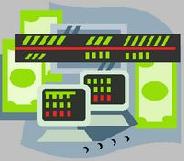
 |
|
| Financial Terms | |
| Accounts receivable |
|
Information about financial, finance, business, accounting, payroll, inventory, investment, money, inventory control, stock trading, financial advisor, tax advisor, credit.
Main Page: tax advisor, money, stock trading, financial advisor, inventory, accounting, business, investment, |
Definition of Accounts receivable
Accounts receivableA current asset on the balance sheet, representing short-term Accounts ReceivableAmounts due from customers for sales on open account, not evidenced ACCOUNTS RECEIVABLEAmounts owed to a company by customers that it sold to on credit. Total accounts receivable are usually reduced by an allowance for doubtful accounts. Accounts receivableAmounts owed to the company, generally for sales that it has made. Accounts receivableMoney owed by customers. Accounts ReceivableMoney owed to a business for merchandise or services sold on open account. accounts receivableShort-term, non-interest-bearing debts owed to a
Related Terms:Accounts receivable turnoverThe ratio of net credit sales to average accounts receivable, a measure of how  Average age of accounts receivableThe weighted-average age of all of the firm's outstanding invoices. accounts receivable turnover ratioA ratio computed by dividing annual Accounts Receivable Days (A/R Days)The number of days it would take to collect the ending Unbilled Accounts ReceivableRevenue recognized under the percentage-of-completion Discounting of Accounts ReceivableShort-term financing in which accounts receivable are used as collateral to secure a loan. The lender does not buy the accounts receivable but simply uses them as collateral for the loan. Also called pledging of accounts receivable. Aging scheduleA table of accounts receivable broken down into age categories (such as 0-30 days, 30-60 Average collection period, or days' receivablesThe ratio of accounts receivables to sales, or the total Cash conversion cycleThe length of time between a firm's purchase of inventory and the receipt of cash Collection policyProcedures followed by a firm in attempting to collect accounts receivables.  Current assetsValue of cash, accounts receivable, inventories, marketable securities and other assets that FactorA financial institution that buys a firm's accounts receivables and collects the debt. FactoringSale of a firm's accounts receivable to a financial institution known as a factor. Maturity factoringFactoring arrangement that provides collection and insurance of accounts receivable. Old-line factoringFactoring arrangement that provides collection, insurance, and finance for accounts receivable. Other current assetsValue of non-cash assets, including prepaid expenses and accounts receivable, due Receivables balance fractionsThe percentage of a month's sales that remain uncollected (and part of Receivables turnover ratioTotal operating revenues divided by average receivables. Used to measure how Short-term solvency ratiosRatios used to judge the adequacy of liquid assets for meeting short-term ACID-TEST RATIOA ratio that shows how well a company could pay its current debts using only its most liquid or âquickâ assets. Itâs a more pessimisticâbut also realisticâmeasure of safety than the current ratio, because it ignores sluggish, hard-toliquidate current assets like inventory and notes receivable. Hereâs the formula: Current assetsCash, things that will be converted into cash within a year (such as accounts receivable), and inventory.  NUMBER OF DAYS SALES IN RECEIVABLES(also called average collection period). The number of days of net sales that are tied up in credit sales (accounts receivable) that havenât been collected yet. Allowance for doubtful accountsA contra account related to accounts receivable that represents the amounts that the company expects will not be collected. Allowance methodA method of adjusting accounts receivable to the amount that is expected to be collected based on company experience. Bad debtsThe amount of accounts receivable that is not expected to be collected. Direct write-off methodA method of adjusting accounts receivable to the amount that is expected to be collected by eliminating the account balances of specific nonpaying customers. acid test ratio (also called the quick ratio)The sum of cash, accounts receivable, and short-term marketable bad debtsRefers to accounts receivable from credit sales to customers cash flow from operating activities, or cash flow from profitThis equals the cash inflow from sales during the period minus the cash current assetsCurrent refers to cash and those assets that will be turned mark to marketRefers to the accounting method that records increases Average Collection PeriodAverage number of days necessary to receive cash for the sale of Allowance for bad debtsAn offset to the accounts receivable balance, against which Current assetTypically the cash, accounts receivable, and inventory accounts on the FactoringThe sale of accounts receivable to a third party, with the third party bearing Quick assetAny asset that can be converted into cash on short notice. This is a subset RevenueAn inflow of cash, accounts receivable, or barter from a customer in exchange aging scheduleClassification of accounts receivable by time outstanding. Allowance for Doubtful AccountsAn estimate of the uncollectible portion of accounts receivable Days StatisticsMeasures the number days' worth of sales in accounts receivable (accounts receivable FactoringThe discounting, or sale at a discount, of receivables on a nonrecourse, notification Provision for Doubtful AccountsAn operating expense recorded when the allowance for Restructuring ChargeA special, nonrecurring charge taken in conjunction with a consolidation Cash CycleThe length of time between a purchase of materials and collection of accounts receivable generated by the sale of the products made from the materials. Collection DepartmentAn internal department within a company staffed by specialists in collecting past due accounts or accounts receivable. FactoringType of financial service whereby a firm sells or transfers title to its accounts receivable to a factoring company, which then acts as principal, not as agent. Quick RatioThe simple ratio of a company's liquid assets to current liabilities. Such assets include cash, marketable securities, and accounts receivable. Working CapitalFunds invested in a company's cash, accounts receivable and inventory. Net working capital is current assets minus current liabilities. Accounts payableMoney owed to suppliers. Days in receivablesAverage collection period. IRA/Keogh accountsSpecial accounts where you can save and invest, and the taxes are deferred until money ACCOUNTS PAYABLEAmounts a company owes to creditors. NOTES RECEIVABLENotes receivable are promissory notes that the company has accepted from its debtors. Most promissory notes pay interest. Those that are due within a year are shown under âCurrent Assets.â Those that mature in more than a year would be listed under âLong-term Assets.â If a note is being AccountsâBucketsâ within the ledger, part of the accounting system. Each account contains similar transactions (line items) that are used for the production of financial statements. Or commonly used as an abbreviation for financial statements. Accounts payableAmounts owed by the company for goods and services that have been received, but have not yet been paid for. Usually accounts payable involves the receipt of an invoice from the company providing the services or goods. Notes receivableAmounts owed to the company that have been formalized by a legal agreement called a note. Permanent accountsThe accounts found on the Balance Sheet; these account balances are carried forward for the lifetime of the company. Temporary accountsThe accounts found on the Income Statement and the Statement of Retained Earnings; these accounts are reduced to zero at the end of every accounting period. accounts payableShort-term, non-interest-bearing liabilities of a business Accounts payableAcurrent liability on the balance sheet, representing short-term obligations Chart of accountsA listing of all accounts used in the general ledger, usually sorted in Balance of Payments AccountsA statement of a country's transactions with other countries. National Income and Product AccountsThe national accounting system that records economic activity such as GDP and related measures. Accounts PayableAmounts due to vendors for purchases on open account, that is, not evidenced Accounts Payable Days (A/P Days)The number of days it would take to pay the ending balance Monetary / non-monetary methodUnder this translation method, monetary items (e.g. cash, accounts Cost Plus Estimated Earnings in Excess of BillingsRevenue recognized to date under the percentage-of-completion method in excess of amounts billed. Also known as unbilled accounts Related to : financial, finance, business, accounting, payroll, inventory, investment, money, inventory control, stock trading, financial advisor, tax advisor, credit. |